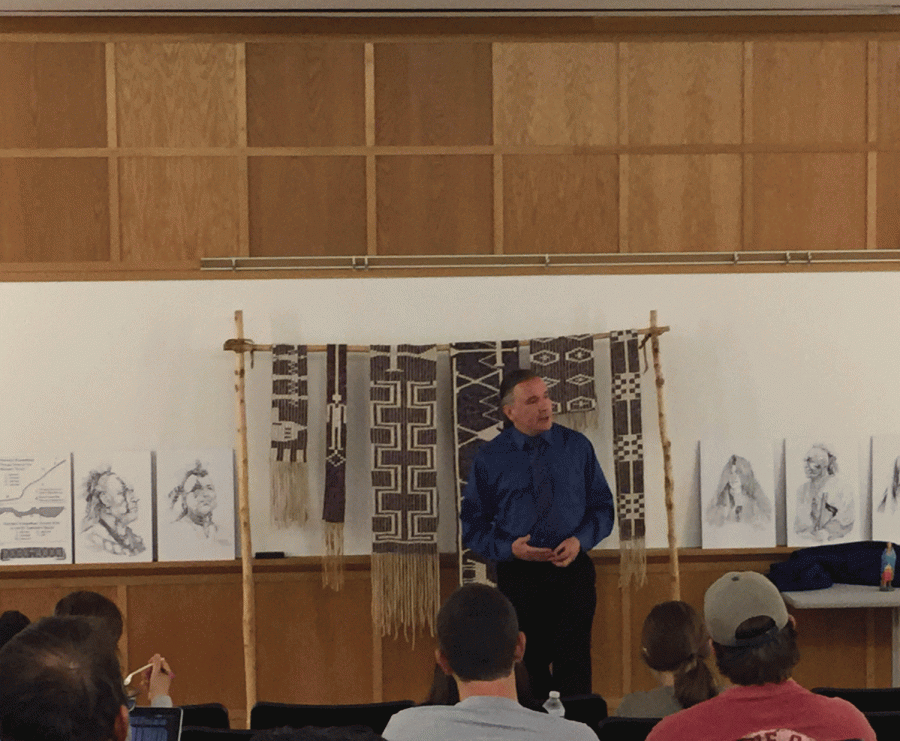Darren Bonaparte Breaks Down Identity of Native American Saint
A LILY AMONG THORNS: Darren Bonaparte spoke about Native American and Catholic Saint Káteri Tehahkwí:tha.
Students, professors and community members gathered Wednesday, September 21 to hear Mohawk historian and lecturer Darren Bonaparte speak about the life of Káteri Tekahkwí:tha. Known to many as Saint Catherine, Káteri was born Mohawk and later baptized as a Catholic. Her subsequent and significant influence over many Christians resulted in her 2012 canonization by Pope Benedict XVI. In his talk, Bonaparte asked listeners to view Káteri from a Mohawk perspective, arguing that her Indian roots worked in conjunction with her Catholic identity to make her who she was.
Harry Emerson Fosdick Professor of the Humanities, Native American Studies and Religion Chris Vecsey, introduced Bonaparte to the audience and detailed the speaker’s background. Bonaparte is the author of two books: “A Lily Among Thorns,” which traces Káteri’s life, and “Creation & Confederation,” which is focused on the history of the Iroquois. Bonaparte also runs his own website, “The Wampum Chronicles,” that is home to photos, articles and historical Mohawk documents.
According to Bonaparte, Káteri’s identity cannot be understood independently of historical context. Born in 1656, the future saint grew up during a pivotal period of contact between Europeans and American Indian tribes. Traders, explorers and missionaries flocked to North America in pursuit of furs, land and converts. Their arrival resulted not only in a tense political climate, but also in the outbreak of disease. In 1661, a smallpox epidemic hit Káteri’s village. She lost her mother, father and brother, and she was left visually impaired herself. Later, Káteri was forced to flee her village as French armies ravaged and ransacked Mohawk
communities. It is interesting and ironic, Bonaparte noted, that these French warriors nearly killed a girl they would later revere.
When Káteri moved to a new village, missionaries came too. Though Mohawk parents were discouraging, many girls were enraptured by the Jesuits’ statements and secretly met with priests for baptisms. Several young women moved north of their Mohawk villages to the banks of the St. Lawrence River, where they fully embraced Christianity. Káteri was one of these girls. She was baptized as Catherine and lived with Jesuits in Quebec, where she devoted herself to religion. Her piety did not go unnoticed. Many missionaries, impressed by Catherine’s zeal, determined her to be an especially holy individual.
One aspect of this holiness was Catherine’s willingness to
suffer for her religion. She and many others engaged in flagellation; that is, beating oneself to show devotion and fortitude. As a result of this practice, though, Catherine’s health began to fail. She consequently passed away at the age of twenty-four.
After Catherine’s death, several Jesuits reported visions of the young woman. They said Catherine spoke to them and helped them in times of need, and that images of her were equally mesmerizing and healing. The priests’ reports contributed to their view of Catherine as holy. In years to come, individuals would revere Catherine so much so that she was considered saintly. It was not until 2012 that this perspective was transformed into reality: over three hundred years after her death, Catherine was canonized in Vatican City.
Bonaparte concluded his talk by addressing Catherine’s legacy. Today, Iroquois and Catholics alike continue to respect and remember the woman who affected so many so long ago. Bonaparte referred to Catherine’s story as a special link between Mohawks and the French. Indeed, Bonaparte’s view is one that acknowledges Catherine’s origins but accepts her conversion. To him, just as the histories of Europeans and American Indians are intertwined, so are Catherine’s identities connected. It is important, then, to understand and recognize not only Saint
Catherine, but also Káteri Tekahkwitha. Sophomore Maggie Dunn was already familiar with Káteri’s story. A student of Professor Vecsey’s “The Iroquois,” Dunn has been reading “A Lily Among Thorns.”
“In Bonaparte’s book, much of Catherine’s story is told through journals of priests and missionaries,” Dunn said. “Hearing the author’s own voice added extra character to an already intriguing history.” Professor Vecsey was also intrigued. Bonaparte’s final remarks about Catherine’s modern relevance particularly resonated with him.
“Darren Bonaparte is one of the leading Iroquois intellectuals of his generation. Multi-talented: artist, historian, orator, organizer,” Vecsey said. “He showed us how Iroquois people perceive their past, and how vibrant they are in the present.”







